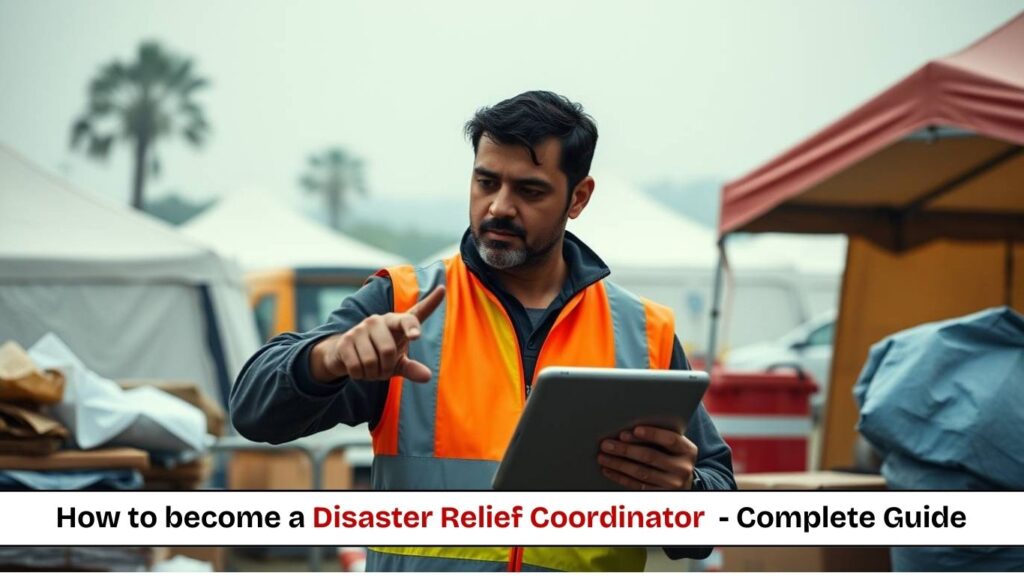
Introduction: The Critical Role of Disaster Relief Coordinators
Disaster Relief Coordinators serve on the frontlines of global crises, orchestrating life-saving responses to hurricanes, earthquakes, pandemics, and human-made disasters. With climate-related disasters increasing 83% in the past 20 years (UN Office for Disaster Risk Reduction), these highly skilled professionals have never been more essential.
This definitive guide covers:
✔ Historical evolution of organized disaster response
✔ 2024 salary data across sectors and regions
✔ Core responsibilities in emergency management
✔ Essential qualifications and career pathways
✔ Step-by-step getting started guide
✔ Future trends in climate resilience and humanitarian tech
Whether you’re drawn to international aid work or domestic emergency management, this guide provides your roadmap to launching this impactful career.
History of Disaster Relief Coordination
Early Civil Protection (1800s-1920s)
- 1859: Henry Dunant founds Red Cross after Battle of Solferino
- 1900: First US Federal disaster response after Galveston Hurricane
- WWI-era: Formalized military-style relief systems emerge
Modern Systems Develop (1930s-1980s)
- 1950: U.S. Civil Defense programs created
- 1979: FEMA established in the United States
- 1980s: UN Office for Disaster Risk Reduction formed
Professionalization Era (1990s-Present)
- 2005: Hurricane Katrina spurs major reforms
- 2006: Cluster system revolutionizes UN response
- 2010s: Digital humanitarianism emerges
- 2020: COVID-19 tests global response systems
Disaster Relief Coordinator Salaries (2024)
Salaries vary dramatically by sector, location, and crisis type:
| Position | Nonprofit | Government | Private Sector | Military |
|---|---|---|---|---|
| Field Coordinator | $48,000 | $62,000 | $75,000 | $54,000 |
| Program Manager | $65,000 | $78,000 | $92,000 | $68,000 |
| Director Level | $82,000 | $110,000 | $140,000+ | $85,000 |
Top-Paying Sectors:
- Private Sector (Disaster consulting firms)
- UN Agencies (P4-level positions)
- Federal Emergency Management
International Salary Ranges:
- UK: £35,000-£85,000
- UAE: $60,000-$120,000 (humanitarian hubs)
- Kenya: $40,000-$75,000 (regional headquarters)
Roles & Responsibilities
Pre-Disaster Phase
- Risk assessments and vulnerability mapping
- Preparedness training for communities
- Supply chain logistics planning
Response Phase
- Rapid needs assessments within 72 hours
- Coordination of multi-agency responses
- Resource allocation under pressure
Recovery Phase
- Long-term rebuilding program design
- Psychosocial support initiatives
- Lessons learned documentation
Specialized Functions
- Refugee camp management
- Displacement tracking
- Donor relations and reporting
Education & Qualifications
Minimum Requirements
- Bachelor’s in:
- Emergency Management
- Public Health
- International Relations
Preferred Qualifications
- Master’s in:
- Humanitarian Assistance
- Disaster Resilience
- Public Administration
Essential Certifications
✔ FEMA Professional Development Series
✔ Sphere Project Standards
✔ HEAT Training (high-risk environments)
✔ Certified Emergency Manager (CEM)
Critical Skills
- Crisis decision-making
- GIS mapping proficiency
- Cross-cultural communication
- Budget management
How to Become a Disaster Relief Coordinator
Step 1: Build Foundations
- Volunteer with:
- Local CERT teams
- Red Cross chapters
- Search & rescue organizations
Step 2: Gain Field Experience
- Entry-level positions:
- Field Assistant (35,000−35,000−45,000)
- Logistics Officer (40,000−40,000−55,000)
Step 3: Specialize
- Climate adaptation
- Refugee camp management
- Disaster tech (drones, AI mapping)
Step 4: Advance Your Career
- Leadership paths:
- Country Director roles
- UN Cluster Lead positions
- Private sector consultancy
Future of Disaster Relief Coordination
Growing Demand
- 15% projected job growth (BLS)
- New climate migration crises emerging
Key Trends Reshaping the Field
- AI-Powered Early Warning Systems
- Urban Search & Rescue Robotics
- Blockchain for Aid Transparency
- Mental Health-Focused Recovery
- Localization Movement (empowering national staff)
Global Hotspots for Careers
- Pacific Islands (climate resilience)
- Middle East (protracted crises)
- East Africa (drought response)
Is Disaster Relief Work Right For You?
Ideal Candidates Possess:
✔ Resilience in high-stress environments
✔ Cultural adaptability
✔ Problem-solving creativity
✔ Physical/emotional stamina
Career Advancement Paths:
➔ UN Humanitarian Coordinator
➔ Disaster Tech Entrepreneur
➔ Climate Policy Specialist
➔ Emergency Management Director
Getting Started Today:
- Complete FEMA IS-100/200 courses (free online)
- Obtain first aid/EMT certification
- Apply for Red Cross disaster action teams
- Pursue foreign language training (French/Spanish/Arabic)
Conclusion: A Career That Saves Lives
Disaster Relief Coordination offers unparalleled opportunities to:
✓ Deploy cutting-edge humanitarian solutions
✓ Lead teams through historic crises
✓ Build community resilience worldwide
Your journey begins with:
- Building emergency management fundamentals
- Gaining hands-on field experience
- Developing technical specializations













Post Comment